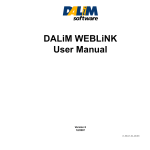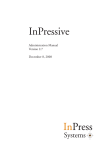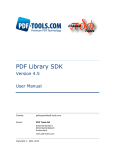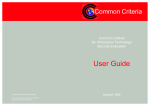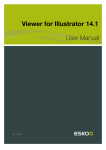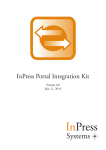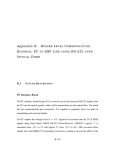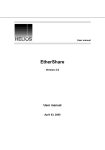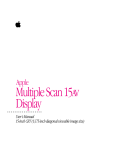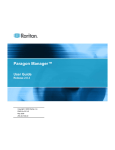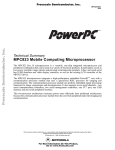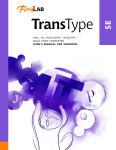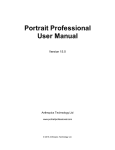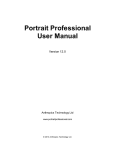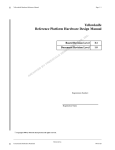Download Documentation
Transcript
WEBLINK Version 7 09/2013 LT_700_01_WL_UM_EN This document contains proprietary and confidential information of DALIM SOFTWARE GmbH. With exception of legally admitted cases is a utilization without agreement of DALIM SOFTWARE GmbH punishable. The contents of this document may not be disclosed to third parties, copied, or duplicated in any form, in whole or in part, without the prior written permission of DALIM SOFTWARE GmbH. DALIM SOFTWARE, TWIST©, LITHO©, DIALOGUE©, WEBLINK©, PRINTEMPO©, MISTRAL©, are registered trademarks of DALIM SOFTWARE GmbH. PostScript© is a registered trademark of Adobe System, Inc. PANTONE© Computer Video simulations displayed may not match PANTONE-identified solid color standards. Use current PANTONE Color Reference Manuals for accurate color. PANTONE©, PANTONE MATCHING SYSTEM©, PANTONE Process Color System© are the property of Pantone, Inc. © Pantone, Inc., 1989, 1996. HKS© is a registered trademark of Wz HKS - Verband. Apple, the Apple Logo, FireWire, GeoPort, HyperCard, LightBulb logo, ImageWriter, LaserWriter, Mac, Mac logo, Macintosh, MessagePad, Newton, OpenDoc, Power Macintosh, PowerBook, QuickTake, QuickTime, QuickTime Logo, and StyleWriter are trademarks of Apple Computer, Inc., registered in the U.S. and other countries. Silicon Graphics, Indigo, IRIS, IRIS Indigo, Open GL, and the Silicon Graphics Company logo are registered trademarks of Silicon Graphics, Inc. CASEVision, CHALLENGE, Indigo2, Indigo Magic, Indy, IndyCam, Indy Video, IRIS GL, IRIS Impressario, IRIS NetWorker, IRIS Showcase, IRIS Volume Manager, IRIX, MovieMaster, NetVisualizer, O2, Octane, Origin, Powered by SiliconGraphics, Showcase, Silicon Studio, WebMagic, WebFORCE and the WebFORCE Logo are trademarks of Silicon Graphics, Inc. Silicon Surf and Silicon Studio are trademarks of Silicon Graphics, Inc. Extreme is a descriptive name used by Silicon Graphics, Inc., under License. Sun, Sun Microsystems, the Sun Logo, SunWorld, Sun SITE, and all Sun-based trademarks and logos, Java, HotJava, JavaScript, the Java Coffee Cup Logo, JavaWorld, and all Java-based trademarks and logos, the Duke Logo, Jini and the Jini Logo, Jiro and the Jiro logo, Solaris, the Solaris Logo, and all Solaris-based trademarks, Netra, Ultra, NFS, iPlanet, the iPlanet Logo, and all iPlanet-based trademarks, We're the dot in .com and The Network Is The Computer are trademarks or registered trademarks of Sun Microsystems, Inc. in the United States and other countries. Linux is a registered trademark of Linus Torvalds. Red Hat is a registered trademark of Red Hat Sotftware, Inc. Color Vérité, FPO Exporter, FullPress FPO, FullPressXT, K-Time, Picture Wrangler, and WebNative are trademarks and FullPress, K-Talk, K-AShare, K-Spool, Queue Master, the Xinet server design, and Xinet are registered trademarks of XINET, Inc. EtherShare, PCShare und SLIC are trademarks of Helios Software GmbH. Ethernet is a trademark von XEROX, Inc. This product is covered by one or more of the following US patents: 5,113,249; 5,323,248; 5,420,702; 5,481,379. Microsoft, Windows, and SQL Server are either registered trademarks or trademarks of Microsoft Corporation in the United States and/or other countries. Macromedia and ColdFusion are trademarks or registered trademarks of Macromedia, Inc. in the United States and/or other countries. All other trademarks and product names are the property of their respective owners. The use of other general descriptive names, trademarks, and so on, in this publication does not imply, even in the absence of a specific statement, that such names are exempt from the relevant protective laws and regulations and therefore free for general use. DALIM SOFTWARE GmbH assumes no responsibility or liability for any errors or inaccuracies that may occur through the use of the software or this manual. DALIM SOFTWARE GmbH reserves the right to modify any part of this document without notice. This document can NOT be part of any sales contract or commitment. Copyright © 1999-2013 DALIM SOFTWARE GmbH. All rights reserved. DALIM SOFTWARE GmbH Straßburger Str. 6 D-77694 Kehl, Germany WEBLINK - User Manual Table of Contents Overview ____________________________________________________________ 1 Introduction............................................................................................................................1 Using this manual...................................................................................................................1 Objectives...............................................................................................................................2 Prerequisites ...........................................................................................................................2 Conventions ...........................................................................................................................2 WEBLINK UI quick-reference ___________________________________________ 3 All windows ...........................................................................................................................3 The WEBLINK UI Toolbox ..................................................................................................3 The Servers window...............................................................................................................3 The Processes window ...........................................................................................................3 The Workflows window....................................................................................................4 The Admin window...........................................................................................................5 Getting started _______________________________________________________ 6 Installation..............................................................................................................................6 How to setup the WEBLINK Engine.....................................................................................6 How to define the WEBLINK UI setup.................................................................................7 How to manage the Users (New version) _________________________________ 9 Overview ................................................................................................................................9 The Roles ...............................................................................................................................9 How to create a role...........................................................................................................9 How to edit a role ............................................................................................................10 How to delete a role.........................................................................................................10 The General tab ...............................................................................................................11 The WEBLINK tab .........................................................................................................11 The DiALOGUE tab .......................................................................................................12 The Organisational units ......................................................................................................12 Table of Contents - i WEBLINK - User Manual How to create a Organisational unit ................................................................................12 How to edit an organisational unit...................................................................................13 How to delete an organisational unit ...............................................................................13 The General tab ...............................................................................................................14 The DiALOGUE tab........................................................................................................15 How to define job rights ..................................................................................................15 Users.....................................................................................................................................16 How to create a user ........................................................................................................16 How to edit a user............................................................................................................17 How to delete a user ........................................................................................................17 The General tab ...............................................................................................................18 The WEBLINK tab..........................................................................................................19 The DiALOGUE tab........................................................................................................19 How to define job rights ..................................................................................................21 Groups ..................................................................................................................................22 Overview .........................................................................................................................22 How to create a group......................................................................................................23 How to edit a group .........................................................................................................24 How to delete a group......................................................................................................24 The General tab ...............................................................................................................24 How to define job rights ..................................................................................................25 Remotely managing TWIST workflows___________________________________ 27 How to launch the WEBLINK UI interface.........................................................................27 How to manage the server....................................................................................................27 How to start the server.....................................................................................................27 How to stop the server .....................................................................................................28 How to manage the workflows.............................................................................................28 Overview .........................................................................................................................28 How to stop a workflow ..................................................................................................29 How to start a workflow ..................................................................................................29 How to define the authorized users .................................................................................29 How to change the priority of a workflow ......................................................................29 ii - Table of Contents WEBLINK - User Manual Uploading files ______________________________________________________ 31 Overview ..............................................................................................................................31 How to upload files ..............................................................................................................31 Uploading files with the java applet...............................................................................31 Sending remote files........................................................................................................32 Remotely managing the processes _____________________________________ 34 Overview ..............................................................................................................................34 Managing the display ...........................................................................................................34 How to refresh the display...............................................................................................34 How to filter the display..................................................................................................34 Managing the processes .......................................................................................................36 How to sort the processes................................................................................................36 How the change the priority of a process ........................................................................36 How to check the processing order of the processes.......................................................36 How to select processes...................................................................................................36 How to delete a process...................................................................................................37 How to validate a process................................................................................................37 How to display a PDF file ...............................................................................................37 How to display the Log information ...............................................................................37 How to display the Workitems.......................................................................................38 Appendix - How to define the users (Old version) _________________________ 39 Overview ..............................................................................................................................39 How to create new users ......................................................................................................39 How to define the access rights to the jobs ..........................................................................41 How to filter the workflows .................................................................................................42 How to remove a user ..........................................................................................................43 How to change the “Root” password ...................................................................................44 How to edit the setup of the current user .............................................................................44 Table of Contents - iii WEBLINK - User Manual iv - Table of Contents WEBLINK - User manual Overview Introduction WEBLINK is a Web-based application allowing you to manage the processing of files from any location through a Web browser. It is made up of two elements: • • The WEBLINK UI module, which is a Graphical User Interface, allowing you to remotely manage the TWIST server. Several screens allow you to: • Manage the users • Start and stop the server • Start and stop the workflows, change their priority • Send files to any running workflow • Change some of the settings of the workflow, depending on the exported PPD • Display the processes, change their priority, validate or remove processes. The WEBLINK Engine module, which is a server used for communication between the WEBLINK UI interface and the remote TWIST Server(s). This module is completely transparent to the user. In this version, the WEBLINK Engine must run on the same workstation as the TWIST Server. For security reasons, the WEBLINK UI module is typically installed on a remote workstation in a so-called “demilitarized zone”, between the firewall at the Web browser's site and the firewall at the WEBLINK Engine and TWIST Server site. • IRIX • Solaris • Windows 95/98/NT/2000 • Windows XP • Mac OS X Using this manual This WEBLINK “User Manual” concentrates on the operational mode of the WEBLINK module. It only describes how to remotely accomplish some of the tasks allowed by TWIST. It does not describe the details of these tasks, as this is the purpose of the TWIST “User Manual”. The supported operating systems are the following: This manual does not need to be read from beginning to end, since you will get the description or procedure you are interested in, by using the “Table of Contents” or index to quickly access it. • Important You can use any Web browser running on any machine around the world to access the WEBLINK UI interface. Linux This manual applies to WEBLINK used with TWIST. 1 WEBLINK - User manual Objectives Prerequisites As you read through this manual and follow the step-by-step procedures, you will be able to: A TWIST software must have been installed and launched at a remote location. • Setup the WEBLINK Engine module You must have access to a Web browser. • Setup the WEBLINK UI interface • Define users • Remotely start and stop the TWIST server. • Remotely manage workflows and processes • Send files to workflows Conventions The buttons, menus, options and entry fields are displayed in bold characters: the Cancel button is one example. The window names are displayed in bold italic: the Brushes Parameters window is one example. The paths, file names and keyboard entries are displayed in italic characters: the Ctrl key is one example. 2 WEBLINK - User manual WEBLINK UI quick-reference All windows Click to display the documentation in PDF format. OK icon. Click to validate the changes and to close the window. Cancel icon. Click to cancel the changes and close the The Servers window Click to stop the TWIST server. window. The WEBLINK UI Toolbox Click to start and stop the TWIST server. Click to manage the processes. Click to start the TWIST server. Click to Start Init the TWIST server. The Processes window Click to select all processes. Click to manage the workflows and send files found on your local host. Click to send files found on the WEBLINK Engine workstation. Click to deselect all processes. Click to delete the selected process(es). Click to validate the selected process(es). Click to manage the users. Click to setup the WEBLINK UI module. This is accessible only to the “Super” user. Click to refresh the display. Display shows the processes created by all users. Click to display only the processes created by the current user. 3 WEBLINK - User manual The process is deselected. Click to select. Display shows only the processes created by the current user. Click to display the processes created by all the users. Click to show all the processes. Click to hide all processes. The rejected processes are hidden. Click to display Click to display the log file. Red box is priority level (1 in this case). Click a box to change priority. The process is rejected. The process is in OK state. them. The process is in Working state. The rejected processes are displayed. Click to hide them. The processes in Validate state are hidden. Click to display them. The process is in Validate state. Click to display the beginning of the log file. Click to go to the end of the log file. The processes in Validate state are displayed. Click to hide them. The processes in OK state are hidden. Click to display them. Click to refresh the log file display. Click to close the log file window. The Workflows window The processes in OK state are hidden. Click to display them. The processes in Working state are hidden. Click to display them. The processes in Working state are displayed. Click to hide them. The process is selected. Click to deselect. 4 The workflow is running. If stopped, click on this icon to start it. The workflow is stopped. If running, click on this icon to stop it. Red box is priority level (1 in this case). Click a box to change priority. Click to upload files to the workflow. WEBLINK - User manual The workflow is not running. File upload is impossible. The Admin window Click to create a user. Shows that a workflow filter is active. Click to change the workflows accessible to this user. In the Workflow filter window, click to grant access to a workflow. Click to change the root password. In the Workflow filter window, click to grant access to all workflows. Click to change the login. In the Workflow filter window, click to forbid access to a workflow. Click to remove the user. In the Workflow filter window, click to forbid access to all workflows. Shows that the user has access to all available worklfows. Click to define a filter forbidding access to some workflows. 5 WEBLINK - User manual Getting started Installation WEBLINK is installed with TWIST. How to setup the WEBLINK Engine To setup the WEBLINK Engine, proceed as follows: 1 Open your favorite Web browser and log to http://hostname:8080/twist, where hostname is the name of the host on which the WEBLINK Engine has been installed: 4 To validate the setup, click the OK button. Note The first time you launch TWiST WEBLiNK you must click the OK button even if you did not make any changes in the default values. This is needed to validate the license key. Setup password: to change the password of the “Setup” user, type the new password in the Setup password field and in the Confirm password field IP filter: this allows you to increase security by defining the IP addresses that will be allowed to enter the setup. You can define several authorized IP addresses by inserting a colon (:) between them. The 127.0.0.0 IP address is always authorized per default meaning you can always access the setup from the machine running the WEBLINK Engine. 2 3 Click on the Setup icon and type the password of the “Setup” user. This user is delivered with WEBLINK and its default name and password is super. The “Setup” user password can be changed in the setup. After typing super, click on the OK button to display the setup screen: Example You can, for example, allow access from all machines of your internal network by typing nnn.nnn.nnn.0 (nnn.nnn.nnn being the address of your network). The zero means that all machines of your network can access. You could allow access from only one specific machine by typing the address of this machine in place of 0. External URL: this URL gives access to WEBLiNK from the outside. It points to the computer on which the WEBLiNK Engine has been installed. 6 WEBLINK - User manual License is valid: the license must have been installed as described in the DALIM SOFTWARE Products installation manual. TWiST Gate: type the name of the TWiST Gate. TWiST Server timeout: type a timeout for the requests to the TWiST Server, in milliseconds. Root folder: this applies to the browser you open in WEBLINK when you upload files to a TWIST workflow. This browser will display the sub-directories of the folder defined in this field. This path is defined on the workstation running the TWIST Server. Example The root (/) directory displayed in the browser corresponds to the root folder defined in the setup (/symlnks/io/jobs if you keep the default). HotFolder Filter: type the path to an executable used to filter the hot folders. The purpose of this executable is to give access only to the hot folders authorized to the current user (it uses as sole parameter the user name of the user currently logged in WEBLiNK). Log Level: select the detail level of the information displayed in the log. How to define the WEBLINK UI setup The WEBLINK UI setup can only be changed by the “Super” user. 1 Log in the WEBLINK UI interface by typing http://hostname:8080/tfront in your favorite browser, where hostname is the name of the host running the WEBLINK UI interface, and login as “Super” user (the default name and password is super). This displays the Setup icon: 2 Click the Setup icon to display the setup screen: 3 Once all desired changes have been made, click the OK button to confirm the changes. 4 You should then click the login icon to change your login: Upload folder: the files you upload are temporarily stored in this folder before being taken into account by the server. If the server workstation has limited disk space, this allows you to define a temporary folder on a machine that has enough disk space to store all the files when they are uploaded. Command for file copy: allows you to define how the files are uploaded to a TWIST workflow. The Unix copy transfers only the file and removes all associated resources. The Helios copy uses the Helios utilities to transfer the files with their associated Mac resources. The Xinet copy uses the Xinet resources (this one does not work with Linux). Use Dynamic Hot Folders: if you select this option, you will be able to manage subdirectories of the workflow's input folder. This is especially useful for dropping files in different input folder subdirectories, depending on their origin or destination. See also the InputFiles TWiST Basic tool documentation. 7 WEBLINK - User manual TFront internal network URL: this is the URL giving access to the WEBLiNK interface from inside the local network. Login either as “root” user or as one of the “standard” users you created in the user management. This will allow you to work with the WEBLINK interface (remember that the “Super” user only allows you to change the setup). Setup User Login / Password / Confirm password: these fields allow you to define a new “Super” user name and password. Setup User IP filter: this allows you to increase security by defining the IP addresses that will be allowed to enter the setup. You can define several authorized IP addresses by inserting a colon (:) between them. The 127.0.0.0 IP address is always authorized per default meaning you can always access the setup from the machine running the WEBLINK UI interface. Example TFront external network URL: this is the URL giving access to the WEBLiNK interface from outside the local network. Use UFO file browser: if this check box is selected, the Jobs icon will give you access to an UFO'like browser to choose the files to upload. If this option is deselected, a much simpler browser will be used, which is faster, as it does not feature the display options found in UFO. Session timeOut: define a time in minutes. The WEBLINK session will be disconnected if no action has occurred during this defined time. Setting this option to -1 means that no time out is defined and the section is never automatically disconnected. If running a WEBLINK version with limited number of user connections, it is recommended to define a time out (such as 60 minutes, for example). Logo URL for upload: this is the path to an image that is displayed in the top of the file upload screen. You can, for example, allow access from all machines of your internal network by typing nnn.nnn.nnn.0 (nnn.nnn.nnn being the address of your network). The zero means that all machines of your network can access. You could allow access from only one specific machine by typing the address of this machine in place of 0. Text message for upload: this is a text that is displayed as a title for the file upload screen. $W displays the name of the current workflow, and $S displays the name of the TWIST server. These commands should be kept as is but you can change the remainder of the text. Twist web server URL: this URL is giving access to the TWIST web server, which runs on the same workstation as the TWIST server. If you keep the default URL pointing to “localhost”, it is assumed that the WEBLINK UI interface also runs on the same workstation. To remotely manage the TWIST server, the WEBLINK UI interface is run from a remote location and so the URL must point not to “localhost” (which is the machine on which you are running the WEBLINK UI interface), but to the remote workstation running the TWIST server. So replace “localhost” by the name of this workstation. Directory server URL: this URL points to the DalimDirectoryServer. It is defined by the installation and should not be changed. 8 Dialog external/internal URL: this URL points to a machine running DIALOGUE, either from outside or inside the local network. This URL is used in case of a JDF approval. Clicking on the link in the WEBLiNK interface automatically opens the DIALOGUE interface corresponding to the URL (see the JDF Approval basic tool). WEBLINK - User manual How to manage the Users (New version) Overview Important This section describes the new version of the User management feature. The description of the old User management feature can still be found in the Appendix. To open the User’s Management interface, click the Administration icon: Important This icon is displayed only if the role attached to your current user has administrative rights (Is Admin checkbox selected). You can use the “Root” user, who has administrative rights, to create other users. The User’s Management feature is based on four elements: Three pre-configured roles are delivered by default: • Operator: this role has only basic rights. • Manager: this role adds some configuration rights such as the users and organisational units configuration. • System Administrator: this role has full rights over all the features of the software. To create a new user, you should proceed as follows: 1 Create new roles, if the default roles do not fulfill your needs. 2 Create an Organisational unit, and define which roles are available for the users included in this unit. 3 Create one or several users inside the organisational unit. 4 Possibly, create groups, and attach one or several of the users to each group. The Roles • Roles: these are a set of rights that define which features may be used. A role is then attached to a user to define the rights of this user. • Users: these define all the people that may use the application. Various configurations are attached to a user, defining some specific working modes. Each user has also a role, that defines its rights on the various features of the software. 1 Click the Administration icon: • Organisational units: these define a gathering of users. One user can be part of only one organisational unit. 2 Double-click Roles: • Groups: these define a grouping of users inside an organizational unit. A user can be part of several groups. Groups are used to restrict some properties of the user, based on the corresponding properties of all the groups to which he belongs. How to create a role To create a role, proceed as follows: 9 WEBLINK - User manual 3 This displays the existing roles. Click the role icon to create a new role: 3 4 Type the name of the new role and click the OK icon: 5 Define the settings in the General, WEBLINK, and DiALOGUE tabs. These tabs are described below. 6 Click the Submit icon to validate the creation: This displays the existing roles. Click a role in the list to display its setup: How to delete a role To delete an existing role, proceed as follows: 1 Click the Administration icon: 2 Double-click Roles: How to edit a role To edit an existing role, proceed as follows: 1 Click the Administration icon: 2 Double-click Roles: 10 WEBLINK - User manual 3 4 This displays the existing roles. Click a role in the list and click the delete icon to delete the selected role: A confirmation window is displayed. Click OK to delete the role. Caution You cannot delete a role that is attached to a user. The General tab Can edit role related access rights: a user with this role can edit the access rights displayed in the Roles part of this tab. This part is not displayed if the checkbox is not selected.The Is Admin and Can create roles or Can edit roles checkboxes must also be selected. Can edit org. unit related access rights: a user with this role can edit the access rights displayed in the Organizational units part of this tab. This part is not displayed if the checkbox is not selected.The Is Admin and Can create roles or Can edit roles checkboxes must also be selected. Can access MISTRAL: this applies only if MISTRAL has been configured to use the same User Server as DIALOGUE and WEBLINK. (options Create MiSTRAL Users on DalimUserServer and DalimUserServer address in the Administration > Global Variables > Common > Application Settings feature of MISTRAL) All other checkboxes are well described in their title. Example Select the Create users checkbox to be able to create users. The WEBLINK tab This tab allows you to define the allowed actions in the WEBLiNK interface: Description: type a description of the role. Is Admin: the Administration icon is not displayed if this checkbox is not selected. However, to be able to manage users, roles and organisational units, the corresponding checkboxes in the remainder of the tab must also be selected. Can edit user related access rights: a user with this role can edit the access rights displayed in the Users part of this tab. This part is not displayed if the checkbox is not selected. The Is Admin and Can create roles or Can edit roles checkboxes must also be selected. Can manage servers: select this checkbox to be able to start and stop the TWIST server. Caution Even if the Server Mode checkbox is selected, a “standard” user cannot StartInit the server. This is reserved for the “root” user. 11 WEBLINK - User manual Can manage workflows: select this checkbox to be able to start and stop the workflows. If it is not selected the role can only change the priority of the workflows and upload files. Can see all workflows: select this checkbox to be able to view all the workflows. If it is not selected, the attached user can only see his own workflows. Most of the options are well described in their title, selecting the checkbox allowing the usage of the corresponding feature. In the case of drop-down lists, you must first select the checkbox and then select a value in the drop-down list. Example To be able to delete notes, you must first select the Can delete notes checkbox, and then choose if the user attached to the role can delete all notes, only the notes of the users attached to the same organisational unit, or only his own notes. Can see all processes: select this checkbox to be able to view the processes of all users. If it is not selected, the attached user can only see his own processes. Can browse jobs: select this checkbox to be able to access the workstation on which the WEBLINK Engine has been installed. If it is not selected, the attached user can only send files found in his own file structure. Can see PPD options: select this checkbox to be able to see and change the PPD settings when uploading a file to a workflow. The Organisational units How to create a Organisational unit To create an organisational unit, proceed as follows: 1 Click the Administration icon: 2 The existing units are displayed under the Users and Roles lines: Can validate process: select this checkbox to be able to validate a process waiting in Validate status. Can change process priority: select this checkbox to be able to change the priority of the processes. The DiALOGUE tab This tab allows you to define the rights on various features of DIALOGUE: Note The names displayed in the screenshot are the names given during the creation of the units. 3 12 To create a new unit, click the org. unit icon: WEBLINK - User manual 4 Type the name of the new unit and click the OK icon: 5 Define the settings in the General and DiALOGUE tabs. These tabs are described below. 6 Click the Submit icon to validate the creation: How to edit an organisational unit 3 This displays the setup of the selected organisational unit, allowing you to change them. 4 Click the Submit icon to validate the changes: How to delete an organisational unit To delete an existing organisational unit, proceed as follows: 1 Click the Administration icon: 2 Click the unit you want to delete: 3 Click the delete icon to delete the selected organisational unit: To edit an existing organisational unit, proceed as follows: 1 Click the Administration icon: 2 Click the unit you want to edit: 13 WEBLINK - User manual Import Freq. (mn): defines the frequency in minutes at which the users are updated from the LDAP or Active Directory server. Keep LDAP Hierarchy: in case of an Active Directory mode, the users are structured in a directory tree. Select this check box to keep this hierarchy. Each “organizational unit” of the directory tree then triggers the creation of an organization, creating a hierarchy of organizations similar to the one defined in the Active Directory tree. 4 A confirmation window is displayed. Click OK to delete the unit. The General tab Import global users and groups: in case of the Active Directory mode, there is a group of users defined as system users in a specific branch of the users organizational tree. Selecting this check box also imports these users. Users DN: in case of the LDAP (Flat) mode, type the starting user DN. Users to import will be searched on the entire subtree under the defined user DN. This information is optional. Description: type a description of the unit. Use LDAP: select this option to authenticate users from an LDAP or Active Directory server. Note The DalimDirectoryServer queries the LDAP or Active Directory server, based on the information defined in the following options, when you click the Submit icon. This can take a few seconds, depending on the amount of users and groups to synchronize. When done, you can check the users and groups by double-clicking the Organizational unit, and then double-clicking the Users or Groups line. Host / Port: IP address of the machine hosting the LDAP or Active Directory server, and the used communication port. Mode: select either Active Directory or LDAP (Flat). Depending on this choice, additional options are displayed. Principal / Credential: define the login and password required to connect to the LDAP or Active Directory server. The syntax can be DOMAIN/USER. Base DN: this is the domain name. You can type, for example, “dalim.com” or the standard syntax “dc=dalim, dc=com”. 14 Users filter: in case of the LDAP (Flat) mode, this text field allows you to further restrict the users found in the sub-tree under the DN defined in the Users DN option. You can define the objectClass from which the users will be extracted. Groups DN: in case of the LDAP (Flat) mode, type the starting group DN. Users to import will be searched in groups on the entire sub-tree under the defined group DN. This information is optional. Groups filter: in case of the LDAP (Flat) mode, this text field allows you to further restrict the users by restricting the groups found in the sub-tree under the DN defined in the Groups DN option. You can define the objectClass from which the groups will be extracted. Login attribute: in case of the LDAP (Flat) mode, type the attribute used as the user’s login. Default user role: define the default role that all imported users will inherit. As this role is inherited by all imported users, we recommend to use a role with few rights. Roles: the table at the right of the tab allows you to define all roles that will be available for the users attached to the unit. Click the checkbox in the leftmost column to select a role. WEBLINK - User manual The DiALOGUE tab Max Document: type the number of documents that a user attached to this unit can open at the same time. You can define a different number of documents for each user included in the unit, but no user can open more documents than the number defined for the unit. To limit access to some directories of the job structure, define the authorized job structure in the following way: 1 Click the plus icon: 2 This opens a browser: 3 Click on one of the folder icons to limit access to this directory. 4 This displays the contents of this directory and allows you to continue going down into the hierarchy. To go up in the hierarchy, you can click on the Up icon: Note The number of documents is always limited by your DiALOGUE license, even if you define a larger number. How to define job rights The Root Job panel in the DiALOGUE tab allows you to define the access rights of the users to different job structures. The allowed job structure can be further detailed for each user included in the organisational unit, but a user can never access a job that is not authorized for the unit he is included in. Important To be able to define the authorized job structure you must be logged in with a user whose role has the Is Admin, the Can create org. units and the Can edit org. Units checkboxes selected. You can either keep things as they are to give the user access to all sub-directories of the root directory, down to any level of sub-directories, or limit access to one or several branches of the hierarchy. You can also create a directory by clicking the Plus icon: Note The “root” folder is the one defined in the Document root folder option of the DiALOGUE Engine setup. Type the name of the new directory and click the OK icon. The new directory is created as a sub-directory of the currently open directory. 15 WEBLINK - User manual You can also delete the currently open directory by clicking the Minus icon: 5 To validate the directory, click the OK icon: 6 This adds the directory and all its sub-directories to the authorized directories: 7 You can add more directories by clicking again the Plus icon. 8 To edit or delete one of the directories, select the directory and click the Edit or Delete icon. 2 Double-click the unit in which you want to create a user: 3 Double- click Users: 4 This displays the list of the users already existing in the organisational unit: 5 Click the user icon: 6 Type the name of the new user and select a role. Type also twice the password: Caution The radio buttons do not define which directory will be authorized, they only allow you to select the directory you want to edit or delete. As all displayed directories and their sub-directories are authorized, you may want to delete the / branch to limit the jobs that can be accessed by the users. Users How to create a user In a first version, you must create the users inside an organisational unit. Proceed as follows: 1 16 Click the Administration icon: WEBLINK - User manual 4 This displays the list of the users already existing in the organisational unit: 5 Select a user. This displays the setup of the selected user, allowing you to change it. 6 Click the Submit icon to validate the changes: Note You can only choose one of the roles that have been authorized in the organisational unit. 7 Click the OK icon. 8 Define the settings in the General, WEBLINK, and DiALOGUE tabs. These tabs are described below. 9 Click the Submit icon to validate the creation: How to edit a user To edit an existing user, proceed as follows: 1 2 3 Click the Administration icon: How to delete a user To delete an existing user, proceed as follows: 1 Click the Administration icon: 2 Double-click the unit in which you want to delete a user: Double-click the unit in which you want to create a user: Double- click Users: 17 WEBLINK - User manual 3 Double- click Users: 4 This displays the list of the users already existing in the organisational unit: 5 Select the user you want to delete, and click the delete icon: The General tab This tab allows you to define some basic parameters of the user. You can make changes only if the role attached to your current user allows these changes. Example You can change the password only if the Is Admin, Can edit users and Can change passwords checkboxes are selected in the General tab of the Role. 6 A confirmation window is displayed. Click OK to delete the user. Note If you want to temporarily prevent a user from logging into DiALOGUE, you can deselect his Enabled checkbox instead of deleting him. Enabled: you can deselect this checkbox to prevent the user from logging into DiALOGUE. This allows you to temporarily disable a user instead of deleting him. Role: this drop-down list allows you to change the role attached to the user. Only the roles authorized for the organisational unit are displayed. Password/Confirm: these textfields allow you to change the password of the user. You must type the same password in the Password and Confirm fields. Language: select the language of the interface. Length unit: select the unit that will be used for the display of measurements. Color: this option lets you choose the color that will be assigned to the notes and outlines created by the user. In this way you will be able to identify the user who created a note if 18 WEBLINK - User manual several users are reviewing and annotating the same page. You can also change this color if the outlines you draw do not show over the background color of the document. To choose a color, click the color patch. This displays a Color Picker window. Resolution unit: select the unit that will be used for the display and selection of resolutions. If you select an applet that does not correspond to the speed of your connection, this will change nothing to the speed of the upload, but the running indicator will move very slowly. Auto Refresh: type a time in seconds. 0 means that the auto refresh feature is not activated when displaying the processes in WEBLINK, requiring a click on the refresh icon: Define all other basic information of the user in the corresponding text fields. Note The Email is used to notify automatically the user in case of changes in the directories to which he subscribed. As the auto refresh may take a few seconds each time it occurs, you can leave this field to 0 to refresh manually on request. The DiALOGUE tab The WEBLINK tab Use Java applet for upload: select this checkbox to use the a java applet allowing to optimize the upload of files. If you do not have the right to download java applets (because of the configuration of your internet access), you should deselect this checkbox. When the checkbox is deselected, the HTML upload interface is used by default. Java applet mode: when the Use Java applet for upload checkbox is selected, you can choose the applet that will be used, depending on the type of web connection you are using. Each applet is optimized for the speed of the connection: • Local Network: the files are downloaded in non compressed 1 MB parts, with 10 threads. • High speed: the files are downloaded in compressed 1 MB parts, with 10 threads. • Medium speed: the files are uploaded in compressed 512 KB parts, with 5 threads. • Low speed: the files are uploaded in compressed 128 KB parts, with 2 threads. Start fullscreen: select this checkbox to open the documents in full screen by default. Start factor: this option allows you to define the zoom factor at which a document is opened. You can select a zoom factor in percents, or choose Fit in Window to adjust the zoom factor automatically in order to display the whole document in the window. Note This defines the zoom factor used per default when the document is opened, but it can be changed in the document window, once the document is displayed. 19 WEBLINK - User manual Jpeg quality: select a JPEG compression quality for the soft proof file. A minimum or low quality leads to a high compression rate, choosing a lossless or maximum quality will yield a lower compression. Choosing a low JPEG quality (i.e a high compression rate) will speed up the data transfer. Cache paper size limit / Cache % factor: if you zoomed in to display the detail of a small image area, you can display other parts of the page with the same zoom ratio, by dragging the display. The image of this area is displayed in progressively increasing resolution, as in the case of zooming. This allows you to go on with your work without having to wait for final display. These two options allow you to avoid the re-rasterization of the displayed area if you define a big enough cache size. Note Defining, for example, A3 and 100%, means that you can display all parts of an A3 document (or smaller) without rerasterization, as long as the zoom factor is smaller or equal to 100%. This may be useful to display impositions or zoomed in pages. If the defined cache size is big enough the document is rasterized when it is first uploaded and you can display each part of it in the applet window without the need of rerasterizing it. Of course, the required cache size depends on the size of the document, and if you increase the zoom factor to display the document bigger than what is possible with the current cache size, the document will require an additional rasterization. You should notice also that the file size can increase considerably and per default your web browser may not be able to display such big files, in which case an “Out of Memory” message would be displayed. You can solve this by changing the Java Heap Size available for the applet. Pen size: select the width of the outlines drawn when reviewing a document. Closed Loop: the Close Loop Calibration feature, only available as a license option, allows you to ensure that an up-to-date monitor profile is always used. The availability of an up-todate monitor profile is always checked when you first open a document. It is forced again when the profile is out-dated, that is, when the time defined in the Frequency option is over. The Close Loop calibration process uses color patches. A set of color patches is delivered by default (it is the Default Patch that you can select in the Verification patches drop-down list). You can create other color patches that will be displayed in the same drop-down list (see the “How to add color patches for the Close Loop Calibration” section). The White point, Gamma and Max deltaE text fields allow you to define parameters used for the calibration. Display boxes: select this option to display the PDF page boxes, if they are available in the file. When the Display boxes checkbox is selected, you can select the checkboxes corresponding to the boxes you want to display. This displays a color patch allowing you to select the color in which the corresponding box is displayed. To change the color, click the color patch and select a color in the color pick window. Print resolution: select the resolution used to rasterize the document before printing it as displayed on screen, with its current zoom rate, notes and outlines. Background color: in order to check the quality of colors without being disturbed by the background color of the window, you can choose a different color. To change the color, select the checkbox. This displays a color picker window in which to can select a color. Max Document: type the number of documents that the user can open at the same time. You cannot define a number of documents larger than the number that was defined for the organisational unit in which the user is included. Session chat color: this option allows you change the color of the text displayed in the chat window. To change the color, select the checkbox and click the color patch. This displays a color pick window in which you can select a color. 20 WEBLINK - User manual Note font size: select the size of the font displayed in the notes. How to define job rights The Root Job panel in the DiALOGUE tab allows you to define the access rights of the user to different job structures. You can define a different job structure for each user included in an organisational unit, but a user can never access a job that is not authorized for the unit he is included in. 2 This opens a browser displaying all first level directories allowed for the organisational unit: 3 Click on one of the folder icons. 4 This displays the contents of this directory and allows you to continue going down into the hierarchy. To go up in the hierarchy, you can click on the Up icon: Important To be able to define the authorized job structure you must be logged in with a user whose role has the Is Admin, the Can create org. units and the Can edit org. Units checkboxes selected. You can either keep things as they are to give the user access to all sub-directories of the root directories allowed for the organisational unit, or limit access to one or several of the sub-directories. Example The organisational unit has access to the /DiALOGUE and / MiSTRAL/raid directories. If you keep / for the user, this user will have access to all sub-directories of /DiALOGUE and /MiSTRAL/raid. You can limit the sub-directories accessible by the user to / DiALOGUE/PDF-Files and /MiSTRAL/raid/atdMag, for example, but you cannot allow access to a sub-directory outside the /DiALOGUE and /MiSTRAL/raid roots, such as / PRiNTEMPO/PDF-Files. Important The job rights of a user may be restricted if the user is included in one or several groups (see the “Groups” section of this manual). You can also create a directory by clicking the Plus icon: To limit access to some directories of the job structure, define the authorized job structure in the following way: 1 Click the Add icon: Type the name of the new directory and click the OK icon. The new directory is created as a sub-directory of the currently open directory. You can also delete the currently open directory by clicking the Minus icon: 21 WEBLINK - User manual 5 6 To validate the directory, click the OK icon: In a somewhat different way, groups are also used to restrict the job rights of the user. A user attached to several groups will be able to access only a limited part of the folders he is autorized to access, based on the folders authorized for all groups he is attached to. This adds the directory and all its sub-directories to the authorized directories: A simple use of groups is to authorize a user to access all subdirectories of his organisational unit’s root directories. You can then create several groups, each having access to a limited part of these sub-directories. By attaching the user to one or several groups, you limit the user’s authorized directories to the directories authorized in each group to which he is attached. Example 1 Imagine a user, part of an organisational unit. The organisational unit has access to a directory named Folder1. The user has access to /, that is, to Folder 1 and all its sub-directories. Create two groups, each having access to a limited part of the sub-directories: 7 You can add more directories by clicking again the Plus icon. 8 To edit or delete one of the directories, select the directory and click the Edit or Delete icon. Caution The radio buttons do not define which directory will be authorized, they only allow you to select the directory you want to edit or delete. As all displayed directories and their sub-directories are authorized, you may want to delete the / branch to limit the jobs that can be accessed by the users. Groups Overview Groups are used to redefine some properties of the users attached to them. A user attached to several groups will thus have his own roles, as well as all roles authorized for all the groups to which he is attached. 22 • Group1 has access to directories Folder1-1 and Folder1-3-2. Folder1-3-2 is a sub-directory of Folder1-3, itself a sub-directory of Folder1. • Group2 has access to directories Folder1-2 and Folder1-4. By attaching the user to these two groups, you restrict access to all directories authorized for both groups, that is Folder1-1, Folder1-2, Folder1-3-2, and Folder 1-4. WEBLINK - User manual You can also use groups to further restrict authorized directories, when these have already been restricted at the user level. In this case, the authorized directories will be the directories common to the user and all the groups to which he is attached. Example 2 Imagine that the user is now restricted to directories Folder 1-2 and Folder1-3, which are sub-directories of Folder1. With the same groups as in Example 1, the user’s authorized directories are now restricted to Folder 1-2 and Folder1-3-2. Directories Folder1-1, authorized in Group1, and Folder1-4, authorized in Group2, are not authorized because they are not authorized for the user. Folder1-2, authorized for the user, stays authorized because it is authorized in Group2. Folder1-3 is authorized for the user, but only the Folder1-3-2 sub-directory stays authorized because only this sub-directory is authorized in any of the groups (Group1 in this example). How to create a group Proceed as follows: 1 Click the Administration icon: 2 Double-click the unit in which you want to create a group: 3 Double- click Groups. 4 This displays the list of the groups already existing in the organisational unit. 5 Click the group icon: Example 3 This example is a bit different from the previous, in that a third group authorizes Folder1-3. Group1 only authorizes Folder1-3-2, but as Folder1-3 is authorized by Group3, the combination of the directories of all groups authorizes Folder1-3. 23 WEBLINK - User manual How to delete a group To delete an existing group, proceed as follows: 1 Click the Administration icon: 6 Type the name of the new group. 2 Double-click the unit in which you want to delete a group. 7 Click the OK icon. 3 Double- click Groups. 8 Define the settings in the General and DiALOGUE tabs. These tabs are described below. 4 This displays the list of the groups already existing in the organisational unit. 9 Click the Submit icon to validate the creation: 5 Select the group you want to delete, and click the delete icon. 6 A confirmation window is displayed. Click OK to delete the group. The General tab How to edit a group To edit an existing group, proceed as follows: 1 Click the Administration icon: 2 Double-click the unit in which you want to edit a group. 3 Double- click Groups. 4 This displays the list of the groups already existing in the organisational unit. 5 Select a group. This displays the setup of the selected group, allowing you to change it. 6 Click the Submit icon to validate the changes: 24 This tab allows you to define which users are attached to the group, and which roles are allowed by the group. Group Members: this panel displays all users attached to the organisational unit. You can select one or several of them to attach them to the group. Role: this panel displays all roles allowed for the organisational unit. You can select one or several of them to allow them for the group. If a user is attached to one or several groups, his allowed roles will be his own plus all the roles allowed in all the groups to which he is attached. WEBLINK - User manual How to define job rights The Root Jobs panel in the DiALOGUE tab allows you to define the access rights of the group to different job structures. See the “Overview” section to see how this interacts with the job rights of the user. You can either keep things as they are to give the user access to all sub-directories of the root directories allowed for the organisational unit, or limit access to one or several of the sub-directories. Example The organisational unit has access to the /DiALOGUE and / MiSTRAL/raid directories. 3 Click on one of the folder icons. If you keep / for the group, this group will have access to all sub-directories of /DiALOGUE and /MiSTRAL/raid. 4 This displays the contents of this directory and allows you to continue going down into the hierarchy. To go up in the hierarchy, you can click on the Up icon: You can limit the sub-directories accessible by the group to / DiALOGUE/PDF-Files and /MiSTRAL/raid/atdMag, for example, but you cannot allow access to a sub-directory outside the /DiALOGUE and /MiSTRAL/raid roots, such as / PRiNTEMPO/PDF-Files. To limit access to some directories of the job structure, define the authorized job structure in the following way: 1 You can also create a directory by clicking the Plus icon: Click the Add icon: Type the name of the new directory and click the OK icon. The new directory is created as a sub-directory of the currently open directory. 2 You can also delete the currently open directory by clicking the Minus icon: This opens a browser displaying all first level directories allowed for the organisational unit: 5 To validate the directory, click the OK icon: 25 WEBLINK - User manual 6 This adds the directory and all its sub-directories to the authorized directories: 8 To edit or delete one of the directories, select the directory and click the Edit or Delete icon. Caution The radio buttons do not define which directory will be authorized, they only allow you to select the directory you want to edit or delete. As all displayed directories and their sub-directories are authorized, you may want to delete the / branch to limit the jobs that can be accessed by the users. 7 26 You can add more directories by clicking again the Plus icon. WEBLINK - User manual Remotely managing TWIST workflows How to launch the WEBLINK UI interface To launch the WEBLINK interface, proceed as follows: 1 Open your favorite Web browser and log in http://hostname:8080/tfront, where hostname is the name of the host running the WEBLINK UI interface. This opens a login window asking for a user name and password. 2 Login as “root” or as one of the “standard” users you created previously (see the “How to create new users” section, above). Click on OK to open the main WEBLINK UI screen: This screen displays the server status. If TWIST is working in multi-server configuration, all servers are displayed. In the screenshot example, the “qc-server3” and “vde4” servers are running and the “wserver3” server is stopped. Buttons allow you to stop, start and start init the servers. Caution Only the “root” user can StartInit the server. If you logged in as a “standard” user, only the Start icon is available. If the “standard” user is not allowed to start the server, even this icon is removed. How to manage the server How to start the server If the TWIST server is not running, you can start it remotely: 1 2 To start the server, click the Start icon: Click the Server icon: This keeps all the processes that were queued at the moment the server was stopped. This opens the TWIST Server screen: 3 To start init the server, click the Start Init icon: 27 WEBLINK - User manual This removes all queued processes. Note Please refer to the TWIST User Manual for more information on the TWIST server features. How to stop the server Note Please refer to the TWIST User Manual for more information on the TWIST server features. How to manage the workflows If the TWIST server is running, you can stop it remotely: Overview 1 Click the Server icon: To manage the workflows, click the Workflows icon: This opens the TWIST Server screen: This opens the Workflows window: This window displays all the workflows that have been sent to running servers. The Status column shows if a workflow is currently running or not, and allows to change this status. In the screenshot example, workflows “a_PdfInput” and “A_PsInput” are running while workflow “EAtest” is stopped. Caution This screen displays the server status. If TWIST is working in multi-server configuration, all servers are displayed. In the screenshot example, the “qc-server3” and “vde4” servers are running and the “wserver3” server is stopped. Buttons allow you to stop, start and start init the servers. 2 28 Click the Stop icon to stop the server: If the current user has not the rights to manage the workflows (see the “How to create new users” section above), the screen displays only the status icon but does not allow to change this status: WEBLINK - User manual The third icon from the left allows you to define the users that have the rights to use the workflow. The Name column displays the name of the workflow. The Servers column displays all servers on which the workflow is running. 2 This displays the Access list window: 3 To grant the rights on the workflow to a user, select the user in the left part of the window and click the “right arrow” icon. This displays the user in the right part of the window. The Priority column shows the current priority of the workflow (with the red box) and allows to change it. The Upload column allows you to upload files to a workflow. The screenshot above shows that the Upload icon is inactive for a stopped workflow, meaning that a stopped workflow cannot process files. Note Please refer to the TWIST “User Manual” for all details on workflow management. How to stop a workflow Stopping a workflow stops the servers from monitoring the “hot folder” defined for that workflow. This means that the files dropped into the “hot folder” are no longer processed. To stop a workflow, click on the Stop Workflow icon: When no users are displayed in the right part of the window, this means that the workflow is available for all users. This stops the workflow and displays it in stopped state. How to start a workflow To restart a workflow not currently running, click on the Start Workflow icon: This starts the workflow and displays it in running state. How to define the authorized users To define which users will be able to use a workflow, proceed as follows: 1 Note You must have administrator rights in WEBLINK to be able to change the authorized users. How to change the priority of a workflow The TWIST Server software works on jobs based on the priority defined for each workflow. There are seven priority levels, 1 being the highest priority and 7 being the lowest priority. By default, every workflow sent to the server receives a priority level 4. All files sent to a priority level 1 workflow will be processed first, regardless of when they were sent to the server. If files are sent to a lower priority workflow they will sit in the queue until all higher priority workflows have finished. Click the Access icon in the line corresponding to the workflow: 29 WEBLINK - User manual The seven priority levels are displayed as seven boxes with increasing size. Priority level 7 (that is, the lowest priority level) is the smallest box at the left, and priority level 1 (that is, the highest priority level) is the largest box at the right. The current priority of a workflow is displayed as a red colored box. Example This workflow is in priority 1. 30 This workflow is in priority 4. To change the priority of a workflow, click in one of the boxes. Click, for example, in the smallest box at the left to set the workflow to priority 7. WEBLINK - User manual Uploading files Overview 2 WEBLINK allows you to remotely upload files in workflows running on the TWIST server. This can be done in two ways: Notes • • In the Workflows window you can choose a workflow and then select files to upload to this workflow. These files are located on the machine from which you run the Web browser. Click on the Upload icon displayed in the line of the workflow to which you want to upload files. You cannot upload files to a workflow that is not running, and in this case the Upload icon is inactive. 3 In the Jobs window you can select files and then choose the workflow to which these files will be sent. These files are located on the machine hosting the WEBLINK Engine. Unless the Use Java applet for upload option has been selected in the Setup (tab WEBLINK), the HTML upload window is displayed by default: If the printer queue has been exported in the TWIST Editor, you will be able to change some settings of the workflows through the exported PPD. How to upload files You can always click the Java Upload link to use the Java upload applet: Uploading files with the java applet To upload files found on the machine from which you are running the Web browser: 1 Click the Workflows icon: This opens the Workflows window. 4 If the printer queue has been exported in the TWIST Editor (please refer to the TWIST “User Manual”), the upload screen displays the PPD and allows you to change some settings of the workflow: 31 WEBLINK - User manual This will create a process on the remote TWIST server, and you will be able to check this process in the Processes window of the WEBLINK UI interface. Sending remote files To process files found on the machine running the TWIST Server, proceed as follows: 1 The Server drop-down list displays the list of all running servers, as well as an “empty” choice. If you select the “empty” choice, load-balancing on all running servers is automatic. If you select one of the servers, there is no loadbalancing and the file is uploaded only to the selected server. The left part of the window allows you to navigate through the directories of the workstation running the WEBLINK Engine. You can only display the jobs your user can access (according to the access rights setup, see the “How to define the access rights to the jobs” section). The files and directories can be displayed as icons, as gallery thumbnails or as a text list, by choosing the display mode in the View as icon button. The modifiable settings have been defined in the TWIST Editor through the PPD Manager (see the TWIST “User Manual”). 5 6 After changing the PPD settings (if required), click the Add Files button (in the HTML interface) or the “plus” icon (in the Java interface). This opens a browser window that allows you to select the file(s) to upload. You can also drag-and-drop files in the Drop Area. To remove files from the list of files to upload you can click the Remove icon in the corresponding line (in the HTML interface), or select them and click the “minus” icon (in the Java interface). To upload the files, click the Send Files button (in the HTML interface) or the Start Upload icon (in the Java interface): This uploads the files to the current workflow. 32 Click the Job icon to open the Job browser: Note The screenshot shows the Jufo file browser that can be chosen in the WEBLINK UI setup (see the “How to define the WEBLINK UI setup” section above in this manual). Unchecking the Jufo file browser option displays a simpler browser, with the same look but that does not offer the View as gallery option. 2 Open the directories and sub-directories by clicking on them. 3 Click on the file(s) to process. These files are displayed in the central part of the window. WEBLINK - User manual 4 In the right part of the window, choose the server and the workflow: Note You can also click on the All the folder icon: This selects all the files in the current job (but not in the subfolders). You can then click on the Remove file from list icon to deselect the undesired files: The modifiable settings have been defined in the TWIST Editor through the PPD Manager (see the TWIST “User Manual”). You can click also on the Remove all files from list icon to de-select all the files: 5 After changing the PPD settings (if required), click on the Execute button. This sends the files to the selected server and workflow. 33 WEBLINK - User manual Remotely managing the processes Overview A purple line with a purple icon displays a process in “To treat” mode, waiting for an action in a Workitem. To manage the processes, click the Processes icon: Note When running in multi-server configuration, the processes of all servers are displayed. This opens the Processes window: Managing the display How to refresh the display This window displays all processes or a filtered subset of them. The tool bar allows you to filter the processes as well as to select, delete or validate the processes. The Processes screen can be automatically refreshed at a defined time interval if an Auto Refresh time has been set for the current user (see the “How to create new users” paragraph above in this manual). A green line with a green icon displays a process in OK state, that has successfully passed through all stages of the workflow. It can be advantageous to prevent an automatic refreshment, because it can be time consuming. If the Auto Refresh time has been set to 0 for the current user, you will have to refresh the screen manually. A red line with a red icon displays a process in Rejected state, that has failed somewhere in the workflow. To refresh the screen, click on the Refresh icon: How to filter the display A blue line with a blue icon displays a process in Validation state, waiting for user validation. A yellow line with a yellow icon currently worked on. 34 displays a process being When a lot of files have been sent to the workflows the display can easily become very cluttered up. To reduce the amount of information displayed on screen and concentrate on the required information you can use a filter to display only the currently interesting processes. To display only the processes related to the current user, click on the My processes icon: WEBLINK - User manual To display again the processes of all users, click on the All processes icon: Note To display again these processes, click on the following icon: To hide the processes in Working state, click on the following yellow icon: If the current user has not the right to view the processes of all the users, he will only see his own processes, and My processes and All processes icons are hidden. To hide the rejected processes, click on the following red icon: To display again these processes, click on the following icon: To display again the Rejected processes, click on the following icon: To hide all processes, click on the following icon: To display all the processes, click on the following icon: To hide the processes in Validation state, click on the following blue icon: Example To display again these processes, click on the following icon: To display only the processes in Validate state, you can first hide all processes by clicking on the following icon: To hide the processes in OK state, click on the following green icon: And then display the processes in Validate state by clicking on the following blue icon: 35 WEBLINK - User manual Managing the processes How to sort the processes You can define the order in which the processes are displayed by clicking the Sort icon displayed right of each column: Example This workflow is in priority 1. This workflow is in priority 4. To change the priority of a process, click in one of the boxes. Click, for example, in the smallest box at the left to set the process to priority 7. How to check the processing order of the processes When you click an icon, the processes are sorted based on the corresponding column and the icon changes to show the column used as sort basis: How the change the priority of a process By default all processes have the priority of the workflow but you can change the priority of any particular process, if you were given the right to change it (see the Edit Priority option in the “How to create new users” section). The seven priority levels are displayed as seven boxes with increasing size. Priority level 7 (that is, the lowest priority level) is the smallest box at the left, and priority level 1 (that is, the highest priority level) is the largest box at the right. The current priority of a process is displayed as a red colored box. 36 The Ord column allows you to check the order in which your processes will be processed: This may be especially useful when you can only see your own processes. You may thus not know how many processes will be processed before your own. In the Ord column, you can see two numbers. The second number is the total number of processes that are in the server’s queue, and the first number shows the order in which the processes will be processed. 5/25, for example, means that 25 processes are currently in queue, and that the process is the fifth in line. This means that 4 processes will be processed before this one is processed. How to select processes In order to delete or validate a process it must first be selected. WEBLINK - User manual To select a single process, click in the box left of the processes line. This adds a check mark to show that this process is selected: Note You can also validate individual processes in the Log screen, as shown below. How to display a PDF file To select all the processes, click on the following icon: If a PDF file is in validate state, you can click on its name to display the file in Acrobat Reader: To de-select all the processes, click on the following icon: How to display the Log information How to delete a process If you do not want to work further on a process currently in validate state (for example if the proof shows a problem to be corrected first), you can delete this process. To delete one or several processes, select the process(es) and click on the Delete Selection icon in the toolbox left of the screen: How to validate a process A process in Validate state is waiting for a user interaction (to check a proof, for example). If desired (if the proof is correct, for example), you can then let the process continue by validating the process. To validate one or several processes, select the process(es) and click on the Validate Selection icon in the toolbox left of the screen: To display detailed information about how a specific process moves through each stage of a workflow, click on the LogFile icon: This opens a window displaying the processe's log file: This screen shows all basic tools that have currently processed the incoming file. The information displayed for each basic tool includes its name, the name of the processed file, the type of the processed file, the date and beginning time of the process, and finally the duration of the processing in this file. The duration is expressed as hh:mm:ss, where hh is the number of hours, mm the number of minutes, and ss the number of seconds. To expand the information displayed for a basic tool, click on the Expand icon: 37 WEBLINK - User manual This displays the information sorted in various sub-sections: To display the end of the log file, click on the End button: Once at the end, you can display the beginning of the log file by clicking on the Begin icon: To validate a process waiting in “validate” state, click on the Validate icon: You can further expand the sub-sections to display the detail of the processing: To close the log file, click on the Cancel icon: How to display the Workitems Processes waiting for a user intercation in a Workitem are displayed in purple. To open the Workitem, click the file name: To contract the sub-sections and sections, click on the yellow icon. To refresh the display, click on the Refresh icon: 38 The Workitems are described in the TWIST User manual. WEBLINK - User manual Appendix - How to define the users (Old version) Overview WEBLINK is delivered with a “Setup” user, a “Super” user and a “Root” user: • The “Setup” user gives only access to the WEBLINK Engine setup and its default name and password is super. The password can be changed in the WEBLINK Engine setup, as shown above. • The “Super” user gives only access to the WEBLINK UI setup and its default name and password is also super. You are advised to change this name and password as described in the “How to define the WEBLINK UI setup” section later in this manual. • The “Root” user only gives access to the WEBLINK UI interface. You can additionally create any number of “standard” users allowed to use the WEBLINK UI interface. The “Root” user allows complete control of the WEBLINK UI interface, including the creation and management of users, but the additional “standard” users have no access to the creation and management of users, and may have only restricted access to the WEBLINK UI features. Especially, a “standard” user may only be allowed to start the TWIST server, while the “root” user can achieve a StartInit. 2 Type root in the Login field. The default password is root, but this can be changed in the Users setup screen. Click on the OK button to display the main interface screen: 3 Click on the Admin icon: 4 This opens the user setup screen: 5 To add a new user, click the Create User icon: 6 This opens the user creation window: How to create new users As soon as possible, you should create “standard” users, and use the “root” user only for user management. To create new users, you have to log in the WEBLINK UI interface using the “Root” user: 1 In your favorite browser, log to http://hostname:8080/ tfront, where hostname is the name of the host running the WEBLINK UI interface. This opens a login window: 39 WEBLINK - User manual Auto Refresh: type a time in seconds. 0 means that the auto refresh feature is not activated, requiring a click on the refresh icon: 7 8 Type a user name, and type two times the password, then click the OK icon to create the user. When the user is displayed in the user list, click its Edit icon: This opens the user edition window: As the auto refresh may take a few seconds each time it occurs, you can leave this field to 0 to refresh manually on request. Applet: select this check box to use the a java applet allowing to optimize the upload of files. If you do not have the right to download java applets (because of the configuration of your internet access), you should deselect the Applet check box. When the option is selected, you can choose the applet that will be used, depending on the type of web connection you are using. Each applet is optimized for the speed of the connection: • Local Network: the files are downloaded in non compressed 1 MB parts, with 10 threads. • High speed: the files are downloaded in compressed 1 MB parts, with 10 threads. • Medium speed: the files are uploaded in compressed 512 KB parts, with 5 threads. • Low speed: the files are uploaded in compressed 128 KB parts, with 2 threads. If you select an applet that does not correspond to the speed of your connection, this will change nothing to the speed of the upload, but the running indicator will move very slowly. Jobs root directory: this feature is described in the next section. You can now define the user settings. Email: this can be used in TWIST workflows (with the SendMail tool) to send an email to the user. Language: select one of the available languages to display the WEBLINK UI interface in this language. Unit: select the unit in which the measurements are displayed. 40 Change password: click the icon to change the password of the user. Workflow filter: click this icon to define the workflows that the user will be able to use. Per default this icon shows that no filter is active, thus meaning that the user has access to all workflows: WEBLINK - User manual See the “How to filter the workflows” section below, for more information on this procedure Server mode: select this check box to allow the user to start and stop the TWIST server. In the screenshot above, the “root” user has the right to start and stop the server, while this is not allowed for the “user1” user. Caution Even if the Server Mode check box is selected, a “standard” user cannot StartInit the server. This is reserved for the “root” user. How to define the access rights to the jobs Example You would proceed as follows to give to user csc access rights to the contents of the defaultjob > DalimSoftwareBrochures folder: Click the browse icon in the csc setup window: View all processes: select this check box to allow the user to view the processes of all users. If it is not selected, the user can only see his own processes. Manage workflows: select this check box to allow the user to start and stop the workflows. If it is not selected the user can only change the priority of the workflows and upload files. Can see PPD options: select this check box to allow the user to see and change the PPD settings when uploading a file to a workflow. Can validate job: select this check box to allow the user to validate a job waiting in Validate status. Click on the defaultjob folder icon: Edit Priority: select this check box to allow the user to change the priority of the processes. Allow Jobs: select this check box to allow the user to access the workstation on which the WEBLINK Engine has been installed. If it is not selected, the Jobs icon is not displayed for this user, so he can only send files found in his own file structure. 41 WEBLINK - User manual Click on the OK button: Click on the DalimSoftwareBrochures folder icon: This validates the access rights: This displays the files and folders contained in this folder. All these files and folders will be accessible for review to user “csc”: How to filter the workflows For each user, you can define the workflows that he will be able to use. After the creation of a user, the WorkflowFilter icon shows that no filter is active, meaning that the user has access to all the workflows: To define the authorized workflows, proceed as follows: 42 1 Click on the WorkflowFilter icon. This opens a window showing that the filter is currently not active: 2 Click on the Enable Workflow Filter icon in the top left of the screen: WEBLINK - User manual This displays the list of workflows available on the server: In this way all the workflows are displayed in the right part of the window and you can click on the Remove workflow from list icon to remove some of the workflows from the allowed list: Note You can click on the Remove all workflows from list icon to remove all the workflows displayed in the right part of the window: 4 3 Click the OK icon to accept the changes and close the window: Click the Add a workflow icon to allow a workflow: The workflow is then displayed in the right part of the window to show that the user will be able to use this workflow: The Workflow enabled filter icon then shows that there is an active filter for the user: You can also click the Cancel icon to dismiss the changes: How to remove a user To remove one of the created users, click the Remove icon at the right of the user’s line: You can also click the Add all workflows icon to allow all the workflows: This opens a screen asking you to confirm the deletion: 43 WEBLINK - User manual Click the OK icon to delete the user, or the Cancel icon to keep it. Type the old password and two times the new one, then click the OK icon to approve the change. Note Note You cannot remove the “Root” user, because this user is the only one allowing you to create other users. How to change the “Root” password For security reasons, you can change the “Root” password by clicking the Change Password icon: This opens the following window: 44 You cannot change the password of other created users. If you need to change such a password, remove the user and re-create it. How to edit the setup of the current user If you are not logged in as a user with administrator rights, you can only edit part of the user’s setup: WEBLINK - User Manual Index A Access rights to jobs 15, 21, 25 Active Directory 14 Administration icon 11 Allow jobs 41 Applet 40 Art box Display 20 Auto Refresh 19, 40 B Background color 20 Bleed box Display 20 Boxes Display 20 C Cache % factor 20 Cache paper size 20 Can browse jobs 12 Can change process priority 12 Can manage servers 11 Can manage workflows 12 Can see all processes 12 Can see all workflows 12 Can see PPD options 12 Can validate process 12 Chat Change color of text 20 Close Loop Setup 20 Color of notes and outlines 19 Command for file copy 7 Conventions 2 Create a user 9 D Delete a process 37 DiALOG server URL 8 Directory Authorized in group 25 Authorized in organisational unit 15, 21 Display Filter 34 Refresh 34 Display boxes 20 Display Log file 37 Display PDF file 37 Document Number that can be opened 15, 20 E Edit a group 24 Edit a user 17 Edit priority 41 Email 40 Enabled 18 Engine Setup 6 F File Index - 1 WEBLINK - User Manual Upload 31, 32 Filter the processes display 34 Filter the workflows 42 Fullscreen Dispaly by default 19 G Group Create 23 Edit 24 Overview 22 Root jobs 25 H High speed 19, 40 Hot folder filter 7 I IP Filter 6 Is Admin 11 J Java applet Use 19 Job Authorized in organisational unit 15, 21 Jobs root directory 40 Jpeg quality 20 L Language 40 Launch WEBLiNK UI 27 LDAP 14 Length unit 2 - Index Unit Length 18 Local Network 19, 40 Log file Display 37 Logo URL for upload 8 Low speed 19, 40 M Manage workflows 12, 41 Manager role 9 Max Document 15, 20 Medium speed 19, 40 N Note Change the size of the fon 21 Color 19 Note font size 21 O Objectives 2 Operator role 9 Ord 36 Organisational unit Authorized roles 14 Create 12 Description 9 Edit Unit Edit an organisational unit 13 Organisationl unit Delete 13 Outline WEBLINK - User Manual Color 19 Pen size 20 Overview WEBLiNK Engine 1 WEBLiNK UI 1 P Password 18 Change root password 44 PDF Display file 37 Pen size 20 PPD See options 12 PPD settings 32, 33 Preflight 38 Prerequisites 2 Print resolution 20 Priority Change for process 12 Change for processes 36 Change for workflow 29 Process Can validate 12 Change priority 12, 36 Delete 37 Filter 34 See all 12 Select 36 Sort 36 Validate 37 R Refresh the processes display 34 Remove a user 43 Resolution For print 20 Resolution unit 19 Role Attach to user 16, 18, 24 Authorize in Organisational unit 14 Description 9 Manager 9 Operator 9 System administrator 9 Root folder 7 Root job GroupJob Authorized in group 25 Organisational unit 15, 21 Root password Change 44 S Safety box Display 20 Select a process 36 Server Start 27 Stop 28 Server mode 41 Servers management 11 Session chat window Change color of text 20 Session time-out 8 Setup User IP filter 8 Sort the processes 36 Start a workflow 29 Index - 3 WEBLINK - User Manual Start fullscreen 19 Start the server 27 Stop a workflow 29 Stop the server 28 System administrator role 9 T Text message for upload 8 TFront external URL 8 TFront internal URL 8 Trim box Display 20 TWiST web server URL 8 TWiST5 Gate 7 U Unit 40 Create an organisational unit 12 Delete an organisational unit 13 Resolution 19 Upload Use Java applet 19 Upload files 31, 32 Upload folder 7 Upload from any file structure 12 Use dynamic hot folders 7 Use Java applet 19 Use UFO file browser 8 User Authorize for workflow 29 Change root password 44 Create 9, 16, 39 Delete Delete a user 17, 24 4 - Index Description 9 Edit 17 Enabled 18 Overview 39 Password 18 Preferences 16 Remove 43 Role 18, 24 User color 19 User server URL 8 Users Access rights to jobs 15, 21, 25 Color 19 Max number of documents to open 15 V Validate a process 37 View all processes 41 W WEBLiNK UI Launch 27 WEBLiNK UI setup 7 Workflow Change priority 29 Filter for users 29 Name 29 Priority 29 See all 12 Start 29 Status 28 Stop 29 Workflow filter 40 Workflows WEBLINK - User Manual Filter 42 Index - 5























































